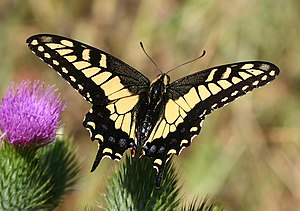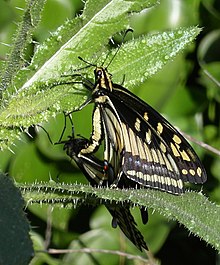Papilio zelicaon
| Papilio zelicaon | ||||||||||||
|---|---|---|---|---|---|---|---|---|---|---|---|---|

Papilio zelicaon |
||||||||||||
| Systematics | ||||||||||||
|
||||||||||||
| Scientific name | ||||||||||||
| Papilio zelicaon | ||||||||||||
| ( Lucas , 1852) |
Papilio zelicaon , also known by the English name Anise Swallowtail ( "Anise swallowtail") is a butterfly from the family of the swallowtail butterfly (Papilionidae).
features
butterfly
The moths reach a wingspan of 70 to 90 millimeters. The forewings are black, when worn off to brown-black. Between the submarginal region and the postdiscal region , a series of large, yellow rectangular spots runs from the front edge to the inside, which almost merge into a band. These become steadily larger towards the inside. Close to the outer edge, parallel to this row, runs another row of much smaller points from the apex to the inner side; in the post-disk region there is a yellow point next to the front edge. In the cell, the wing has two larger, sickle-shaped, yellow spots that are parallel to each other. The outer edge is black, but has black and yellow piebald fringes. In the basal region and in the area between the two rows, the wing is dusted with individual yellow scales . The hind wings are black, when flown off to brown-black and are dusted with yellow scales. In the basal region, the wing is also dusted with individual yellow scales. Furthermore, the outer edge is wavy and has a tail extension. The row of large, yellow spots joins together to form a band and continues through the disk region to the inner edge. This area is pierced by black veins. Above and inside the cell, this area is almost twice as large as the remaining spots on this bandage. The second row of yellow dots on the hind wing also continues parallel to the outer edge in the submarginal region. However, these now have the shape of moon spots and are no longer arranged in a row, but much more scattered. Between these and the bandage, several light blue spots characterize the wing. At the inner corner there is an orange-red eye spot, which is filled with black. But this black does not touch the edge. The outer edge is pied yellow and black.
The underside of the forewings is very similar to the upper side, but all colors are much paler. The underside of the hind wings is also very similar to the upper side, except that all colors are paler. However, all of the features are now increasingly to be found. Only the black basal pollination is weaker and the black post disk band is narrower. The entire basal and disk region is characterized by a yellow area, with all veins highlighted in black. The black postdiskal band is accompanied proximally in each cell by orange spots, which can also appear in the submarginal row of arc spots (especially in females).
The females are much more pollinated and have a stronger body. The body of both sexes is black with wide, yellow side stripes.
The drawing and coloring can, however, vary within the species and led to the description of at least three forms. In the comstocki form , the median ligaments are somewhat narrower. The rare black form nitra (approx. 5 to 20 percent of the population) is from southern Alberta over the western parts of the Dakotas ( North Dakota and South Dakota ) to southern Colorado . In the east, the limit of distribution of the species also forms the limit of this form. They show a series of yellow spots on the abdomen . Occasionally there is a partial second row above this row. Postmedian ligaments are present but vary in width.
The nitra form has also been considered a subspecies by some authors, but the normal form and nitra form can hatch from the eggs of a single female. The form nitra occurs very rarely (in single copies) in Idaho , Utah and in northern New Mexico . In the ampliatanitra form , the post-median ligaments are almost completely absent.
In California, it has been observed that the spring generation differs from the summer generation in smaller drawing details.
Egg, caterpillar and pupa
The eggs are initially creamy white. They later develop a red-brown ring and an equally colored top. The caterpillars of Papilio zelicaon are green or blue-green, rarely almost black, with black transverse lines and yellow spots on the back. Breeding trials under high temperatures usually resulted in black caterpillars. The head is greenish.
As with almost all other swallowtail caterpillars, it scares off enemies with the osmaterium . Five caterpillar stages are known before the caterpillars pupate. The caterpillars are about two inches long before they pupate.
The pupa is brown or green and about three inches long. It can last for one, rarely two winters.
Similar species
Distribution and occurrence
The range of Papilio zelicaon extends from British Columbia and North Dakota to California , Arizona , New Mexico , Baja California, and other parts of Mexico . The species occurs from the coast to above the tree line. Occasionally specimens are still found at 3,000 meters above sea level or even above. Papilio zelicaon is often found on unwooded hills, mountains, gardens, fields, construction sites and roadsides.
Way of life
According to its large distribution area and the large vertical distribution, the species flies in one generation (high altitudes and northern distribution area) or in several generations almost around the year (in southern California). Five or more generations can be formed here. The development from egg to hatching of the butterfly takes 30 to 35 days under laboratory conditions at 23.5 °.
Flight time
In the northern part of the distribution area and in the higher altitudes the flight time extends from May to the end of June or July, in southern California the moths can be found all year round.
pairing
The males wait for females in elevated places on hills or patrol certain routes. This summit balz is known from many Papilio species. The males are very local. Marked males were found in the same places even after a month. Captured males found their traditional territories from up to five kilometers away.
After hatching, the females quickly fly to the top of the hills. The females can mate multiple times (up to three copulations), but the average is less than two copulations. The males also mate several times. After copulation, the females fly rapidly down the hills in search of suitable plants to lay eggs on.
The eggs are laid individually on the leaves and inflorescences of the host plants. The caterpillars are extremely polyphagous; So far, 65 species (in 25 genera) of umbellifers (Apiaceae) and five species (in three genera) of rue plants (Rutaceae) as well as three non-North American species fennel ( Foeniculum vulgare ), orange ( Citrus × aurantium ) and lemon ( Citrus × limoni ) detected as host plants. While the populations in the higher altitudes feed primarily on native plants, the caterpillars of the lowland populations eat almost exclusively the non-native fennel. As a larval food plants are specified: Dill ( Anethum graveolens ), Angelica ( Angelica spp.), Celery ( Apium graveolens ), cicuta maculata , scopulorum Conioselinum , carrot ( Daucus carota ), carrot ( Daucus carota ssp. Sativus ,) Hemlock ( Conium maculatum ), caraway ( Carum carvi ), Harbouria trachypleura , heracleum lanatum , hogweed ( heracleum spondylicum ), Ligusticum porteri , Ligusticum grayi , Lomatium spp., Oenanthe sarmentosa , Zizia aptera , Pseudocymopterus montanus , Pimpinella ( Pimpinella spp.), parsley ( Petroselinum crispum ), Pteryxia spp., Parsnip ( Pastinaca sativa ), Perideridia spp., Sphenosciadium capitellatum , Tauschia spp. and rue ( Ruta graveolens ).
The colonization of the lower and southern regions of the distribution area by Papilio zelicaon was probably only possible after fennel and citrus plants were introduced anthropogenic. Citrus plants and umbellifers contain similar essential oils. These stimulate the eating behavior of the caterpillars.
The egg caterpillars initially prefer leaves, later stages mainly feed on the inflorescences. The pupa hibernates.
Danger
Papilio zelicaon can be found frequently in its range and is therefore not considered threatened.
swell
Individual evidence
- ↑ a b c d butterfliesandmoths.org: Papilio zelicaon ( Memento of the original from August 31, 2009 in the Internet Archive ) Info: The archive link was automatically inserted and not yet checked. Please check the original and archive link according to the instructions and then remove this notice. (accessed on March 15, 2009)
literature
- James A. Scott: The butterflies of North America. Stanford University Press, Stanford, California 1986, ISBN 0-8047-1205-0 , 632 pages.
- N. Mark Collins, Michael G. Morris, and International Union for Conservation of Nature and Natural Resources: Threatened Swallowtail Butterflies of the World: The IUCN Red Data Book. IUCN, 1985, 401 pages, ISBN 2880326036
- Steven R. Sims: Prolonged diapause and pupal survival of Papilio zelicaon Lucas (Lepitoptera: Papilionidae). Journal of the Lepidopterists Society, 37 (1): 29-37, New Haven, Conn. ISSN 0024-0966
- Wayne F. Wehling and John N. Thompson: Evolutionary conservatism of oviposition preference in a widespread polyphagous insect herbivore, Papilio zelicaon. Oecologia, 111: 209-215, Berlin & Heidelberg 1997 ISSN 0029-8549
- Steven R. Sims: Aspects of Mating Frequency and Reproductive Maturity in Papilio zelicaon. American Midland Naturalist, 102 (1): 36-50, Notre Dame 1979 ISSN 0003-0031
